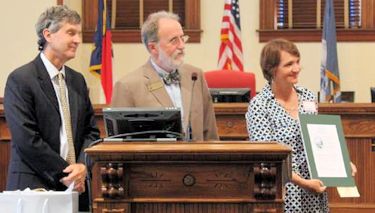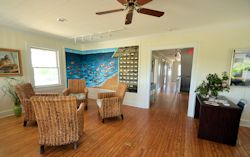By Kyle Magaliff
WILMINGTON — There are certain houses where you always feel at home. It may be the way the old wooden floors creak, or the familiar smoky smell of the fireplace, or maybe even the coastal view from the front porch. That assortment of homey ingredients blend together to create something special — and that’s exactly what the remodeled Palmgren-O’Quinn cottage has provided for the staff at the federation’s new Fred and Alice Stanback Coastal Education Center and Southeast Office.
In recognition of the federation’s use of this historic 1948 home, the federation received a Preservation Award for Rehabilitation and Adaptive Reuse from the Wilmington Historic Foundation. The awards ceremony was held downtown on May 22 at the Historic New Hanover Courthouse where Tracy Skrabal, the southeast regional manager, graciously received the award.
Each year, the Historic Wilmington Foundation awards businesses and organizations that have made efforts to restore and rehabilitate historic properties for continued use. Additional awards were given out for compatible infill and other adaptive reuse projects, as well as the award for Preservationist of the Year.
 Tracy Skrabal accepts the award for the N.C. Coastal Federation. That’s George Edwards,executive director of the Wilmington Historic Wilmington Foundation, center, and Michael Murchison, president of the board of trustees. |
“We thought that the saving of one of those beach cottages and the rehabilitation and adaptive reuse for an office was commendable,” said George W. Edwards, executive director of the organization. “And especially for trying to encourage more of that at the beaches, where unfortunately what happens is things get torn down.”
And torn down is what would have happened to this old home if it were not for the generosity of Debbie and Mark Mitchell, the couple who bought the house from the original O’Quinn family, They then donated the home to the federation following the O’Quinn’s suggestion.
The opportunity to combine natural history preservation with cultural preservation was incredibly important to the federation, Tracy acknowledged, as she believes the two are intertwined. “To be able to work in an historic home that’s been preserved while everything we do is about preserving natural heritage—it’s a perfect fit for us,” Tracy said.
In light of this award, it’s important to acknowledge how this home is integrated into the mission of the federation: to protect and restore North Carolina’s coast through advocacy, restoration, and education. This cottage allows the federation to reach their audiences a bit more intimately—to be just as reachable and approachable as any other next-door neighbor. To that end, the gates have been wide open since the grand opening on May 3 for anyone who wants to stop by and say hello.
As a new intern at the Southeast office, I felt that special at-home feeling the day I walked into the building. I work there three days a week, and each day I feel like I’m strolling into my grandma’s house. The front deck wraps around the house as classic white rocking chairs sway back and forth in the breeze. Walking through the front doors, you will feel obliged to plop down in the cozy living room, equipped with for-sale artwork by Melissa Wilgis—local artist and wife of the federation’s Ted Wilgis. Also contributing to the coastal theme is a mural painted by Tracy’s brother, where metal fish plaques are hung to commemorate the federation’s generous donors.
 The reception area of the new office. |
As you make your way down the hall, you are likely to spot a faithful canine companion sprawled out in the hallway between the offices of Tracy and Mike Giles (right next to the kitchen). As floodplain ordinances prevented the federation from moving the ground floor space of the home, Tracy and Mike have actually used two original wooden doors as their work desks—a testament to the federation’s mission to upcycle and reuse as much from the original home as possible. The floors, stairways, railings and some lighting fixtures are all part of the original home.
The federation also gains a new education classroom, which is intended to foster teaching of the younger generation about coastal issues. This spacious setting, along with the outdoor education area on the bottom floor, is part of the federation’s effort to inform the public on issues such as environmental stewardship, stormwater runoff and water quality. It provides event space for children and adults, such as Touch Tank Tuesdays and a guest speaker series. Joanna Cole, author and creator of “The Magic School Bus” series, is set to come read aloud her new book called “The Magic School Bus and the Climate Challenge.”
The O’Quinn house, back in the middle of the century, held an open door policy for the children of Wrightsville Beach—a policy that the federation will uphold. The yard surrounding is as much a play area for kids as it is an example of simple and convenient sustainability practices. The gutters of the home are designed to drain directly into gardens circumscribing the house, creating a rain garden. This system creates beautiful gardens that consist primarily of native North Carolina plants, and prevent stormwater runoff—the number one cause of water pollution in the state. Another prevention method is the pervious pavement sidewalks running up to the house, which are created with a special type of concrete that allows water to drain right through them. The first time I saw water absorb straight into the concrete, it truly blew my mind.
This home and office, deemed the Fred and Alice Stanback Coastal Education Center, provides examples of environmental stewardship for citizens to use in their own homes, as well as promotes ideas and principles regarding the health of our coast to be embedded in their daily life. All are welcome any time. Whether you are out exploring the town or coming back from your jog around the Wrightsville Beach Loop, stop in for a free tour and meet the staff.
